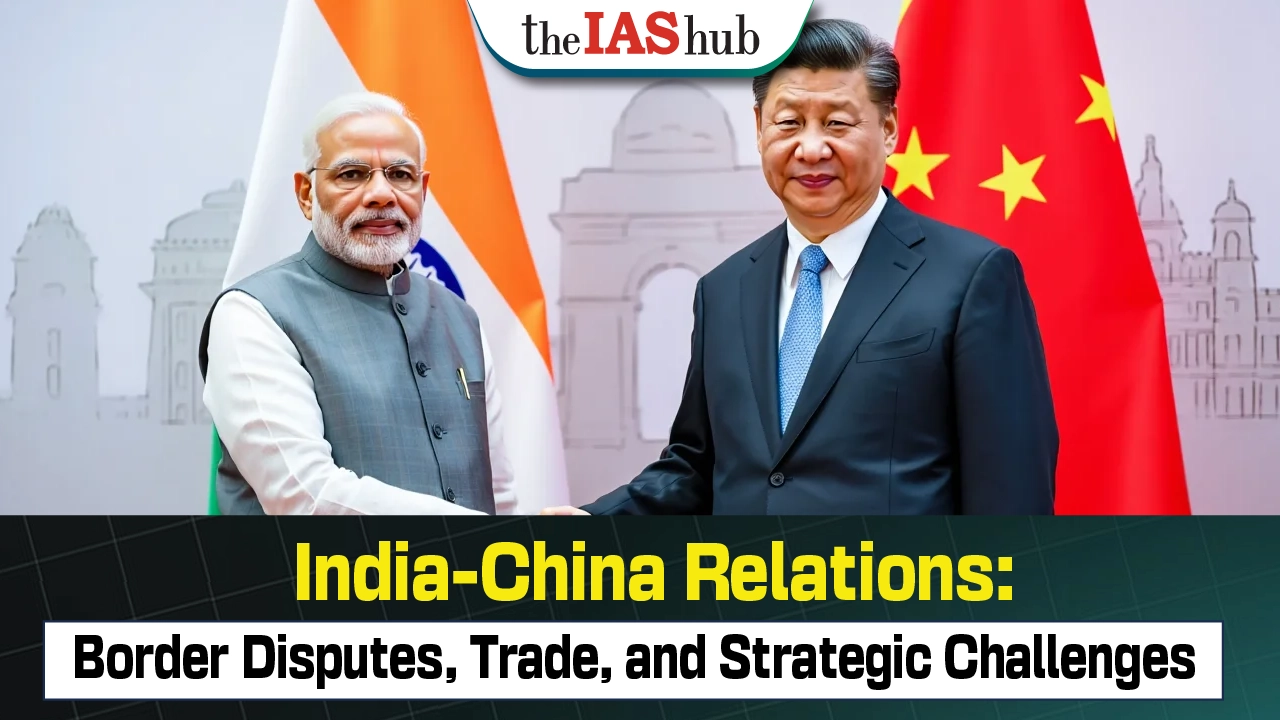India-China Relations have long been complex and multifaceted, characterized by a combination of cooperation, competition, and border disputes. The two Asian giants, with their vast populations, economies, and regional influence, share a significant border and have a history of diplomatic engagements, trade ties, and occasional tensions. The border disputes, particularly in the Western and Eastern sectors, have been a major point of contention, leading to military standoffs and occasional clashes.
Border Dispute in India-China Relations
- Traditional Boundaries: The Himalayas historically acted as a natural boundary between India and China.
- Line of Actual Control (LAC): The disputed 3488 km border is separated by the LAC, which was established after the 1962 war.
- Border in Different Sectors: The border spans across four Indian states and two union territories, with different sectors having varying levels of disputes.

Reasons for Unresolved Border Disputes in India-China Relations
- Geographical Constraints: The difficult terrain, harsh climate, and complex topography make it challenging to demarcate the border accurately.
- Cartographic Issues: British-era agreements and maps have left many areas unmarked or arbitrarily marked, leading to conflicting claims.
- Pressure Tactics: China's use of the border dispute as a pressure tactic and its timing of aggression in response to certain events.
- China-Pakistan Relations: China's reluctance to settle border disputes with India due to its close ties with Pakistan and implications for the Kashmir region.
- Lack of Trust: Differences in long-term regional aspirations and lack of mutual trust hinder cooperation and resolution.
- Other Contentious Issues: Divergent stances on Tibet, Kashmir, and other global forums, as well as nationalist sentiments, contribute to the complexity.
India's Measures in Border Areas
- Infrastructure Development: India has invested in critical border infrastructure, including strategic roads, bridges, and communication networks.
- Strengthening Border Forces: Deployment of the Indo-Tibetan Border Police (ITBP) and the induction of Rafale jets to enhance border security.
- International Cooperation: Collaborating with Japan and promoting connectivity projects in the Northeast region to counter Chinese influence.
|
Vibrant Villages Programme
- The Vibrant Villages program is a government initiative aimed at improving infrastructure and creating job opportunities in villages situated along the Line of Actual Control (LAC) with China.
- It was formally announced in the Union Budget 2022-23 (to 2025-26) for development of villages on the northern borders.
|
Bilateral Trade and India-China Relations
- Increasing Deficit: The trade deficit for 2021-22 reached $73.31 billion, with imports at $60.27 billion and exports at $8.77 billion.
- Growth in Bilateral Trade: Annual two-way trade exceeded $100 billion in 2021, with India's imports accounting for the majority.
- Background of Trade Ties: Trade between India and China surged since the early 2000s, driven by Indian imports of Chinese machinery and equipment.
- Dependency on Chinese Goods: Significant imports from China in machinery, organic chemicals, automotive parts, and fertilizers, integrating China into India's manufacturing supply chain.
- Active pharmaceutical ingredients, auto components, and a large number of medical supplies (since 2020) are other notable imports.
- India's Export to China: China is a major destination for Indian exports, ranking third, but India's share in China's total exports is relatively low. Over the past two years, Indian exports to China have witnessed a remarkable growth rate of over 50%.
- However, the majority of these exports comprise raw commodities such as ores, cotton, and seafood, rather than finished goods.

India's Evolving Economic Relations with China
- The economic relations between India and China have undergone significant changes in the past two years.
- New Delhi has emphasized that it cannot be business as usual while tensions persist along the border. As a result, tighter restrictions have led to a decline in Chinese investment in India.
- Chinese investment in technology and telecommunications start-ups have come to a halt. Prohibitions on 200 apps and restrictions on Chinese firms' participation in 5G trials have been imposed.
- Increased scrutiny of Chinese firm, including tax investigations on companies like Xiaomi, has been initiated by India.
- New Delhi is contemplating a long-term plan to reduce import reliance and identified 12 sectors to boost India's global supplier status and reduce import bill.
Considerations and Implications
- View on Trade Deficit: Trade deficits/surpluses are not direct indicators of a weaker or stronger domestic economy.
- Interconnected Trade Dependencies: India's trade imbalance with China should be viewed in the context of interdependencies, such as imports of ingredients for pharmaceuticals and growing seafood exports to China.
- Challenges of Persistent Trade Deficits: Concerns about foreign exchange reserves availability and the need to enhance domestic production capacity.
India’s Trade War with China
- Negative Consequences: Banning trade with China would primarily harm the Indian poor, punish Indian producers and exporters, and negatively impact sectors like pharmaceuticals.
- Limited Impact on China: A ban on trade with China would have minimal repercussions for China's overall trade, while hurting India's economy.
- Broader Engagement: India's integration with Chinese investments in technology startups and the importance of maintaining policy credibility and attracting foreign investment.
- Trade War and Border Dispute: Turning a border dispute into a trade war is unlikely to resolve the underlying issues, and it would disproportionately harm India.
|
Controversial dams over River Brahmaputra
- China has plans to construct a super dam in Medog County, which is located near Arunachal Pradesh in India.
- The dam will be built on the Yarlung Zangbo River, which is a major tributary of the Brahmaputra River.
- The Yarlung Zangbo River originates in the Tibetan Plateau and flows into Arunachal Pradesh (known as Siang) and Assam (known as Brahmaputra) in India before entering Bangladesh (known as Jamuna).
- -China has already constructed a series of small dams along the Yarlung Zangbo River.
|
Way forward
- Diplomatic Engagement: Maintain regular high-level meetings and negotiations to address issues and build trust.
- Border Management: Strengthen border management mechanisms to prevent tensions and ensure peace and stability.
- Economic Cooperation with Caution: Balance economic cooperation while protecting domestic industries and reducing dependence on Chinese imports.
- Enhancing Strategic Alliances: Strengthen partnerships with like-minded countries to balance China's influence and promote regional stability.
- Defense Preparedness: Strengthen defense capabilities to protect national interests and maintain deterrence.
Conclusion
- Political Consultations for Peaceful Resolution: Political commitment and mutual dialogue are essential for resolving border disputes between India and China.
- Military Communication: Maintaining effective military-to-military communication can help prevent and resolve border-related issues, ensuring peace and tranquility.













